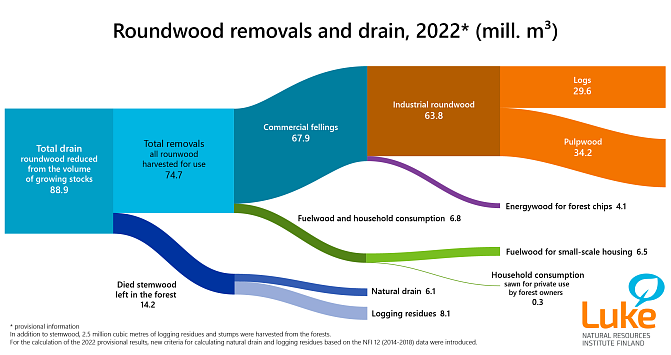Removals decreased to 75 million cubic metres in 2022
According to the preliminary data of the Natural Resources Institute Finland (Luke), Finland’s stemwood removals totalled 75 million cubic metres in 2022. The felling volume of logs was 30, pulpwood 34 and energywood 11 million cubic metres. Both stemwood removals and total drain decreased by two per cent from the previous year. Total drain was 89 million cubic metres.
A total of 64.1 million cubic metres of logs and pulpwood was harvested for industrial use and for the private use by forest owners. This shows a decrease of three per cent from the year before. Higher energy prices increased demand for energywood. The total volume of stemwood harvested directly from forests for forest chips for heat and power plants or fuelwood for use in small-scale housing increased by three per cent to 10.6 million cubic metres.
“The total felling volume, or total stemwood removals, decreased to 75 million cubic metres, down by almost two million cubic metres from the previous year. Still, the volume was slightly higher than the previous five-year average,” says Jukka Torvelainen, senior statistician at Luke.

| 1 | Total drain | 88,9 |
| 1.1. | Total removals | 74,7 |
| 1.1.1. | Commercial fellings | 67,9 |
| 1.1.1.1. | Industrial roundwood | 63,8 |
| 1.1.1.1.1. | Logs | 29,6 |
| 1.1.1.1.2. | Pulpwood | 34,2 |
| 1.1.1.2. | Energywood for forest chips | 4,1 |
| 1.1.2. | Fuelwood and household consumption | 6,8 |
| 1.1.2.1. | Fuelwood for small-scale housing | 6,5 |
| 1.1.2.2. | Household consumption | 0,3 |
| 1.2. | Died stemwood left in the forest | 14,2 |
| 1.2.1. | Natural drain | 6,1 |
| 1.2.2. | Logging residues | 8,1 |
91 per cent of the felling potential covered
According to Luke’s estimate, the sustainable yield of commercial timber and energywood harvested from forests is on average 80.5 million cubic metres of stemwood per year during the ten-year period of 2016–2025. Examined over the whole of Finland, the felling potential has always been higher than the felling volume since the 1970s.
“Felling volumes and felling potential estimates should be compared over periods of several years, because felling volumes fluctuate significantly based on demand for forest industry products. The average value of several years indicates the felling level much more reliably than volumes in individual years. During the last seven years, felling volumes have covered an average of 91 per cent of Finland’s felling potential, with the annual level ranging from 86 to 97 per cent,” says Torvelainen.
According to the preliminary data, 93 per cent of the felling potential was covered in Finland in 2022. In previous years, felling volumes have exceeded the estimated felling potential in Southern Finland with the exception of Uusimaa and coastal areas in Southwest Finland. In Northern Finland, felling volumes have been significantly smaller than the felling potential. The situation will probably remain unchanged when regional statistics for 2022 will be completed in May.
Log removals remained record high
A total of 63.8 million cubic metres of logs and pulpwood was felled for industrial use and exports, down by two million cubic metres from the previous year and equalling the previous five-year average.
Log removals were 29.6 million cubic metres, up by half a million cubic metres from the previous year. The previous five-year average was exceeded by eight per cent.
Removals focused again on spruce logs, with their volume being exceptionally high 16 million cubic metres. Spruce log removals increased by four per cent from the previous year and were 11 per cent above the previous five-year average. Pine log removals were also record-high at 12.5 million cubic metres.

Hardwood pulpwood removals decreased from the previous year
Pulpwood removals of 34.2 million cubic metres were seven per cent smaller than in the year before and in the previous five years. Pine pulpwood removals were 15.5 million cubic metres, marking the lowest volume since 2014. In addition, spruce pulpwood removals decreased by six per cent from the previous year to 10.0 million cubic metres.
“Hardwood pulpwood removals did not increase as expected, but remained at 8.7 million cubic metres. This was nearly a million cubic metres less than in the previous years,” says Tiina Sauvula-Seppälä, senior statistician at Luke.
11 million cubic metres of stemwood felled as energywood
According to the preliminary data, 10.6 million cubic metres of stemwood were felled for use as energy.
The volume of stemwood felled as forest chips for heat and power plants, consisting of delimbed stems or whole trees, was 4.1 million cubic metres. In addition, 2.5 million cubic metres of logging residues and stumps were harvested from forests for energy generation.
Each year, 6.5 million cubic metres of logwood, smallwood and forest chips are burned in small-scale housing. This volume was identified in a survey targeted at the 2016/2017 heating season. The consumption of fuelwood probably increased last year, driven by rising energy prices. As a result, Statistics Finland and Luke will update the volume of fuelwood consumed in small-scale housing during the spring.
Total drain decreased to 89 million cubic metres
In 2022, eight million cubic metres of stemwood remained in forests as logging residues. In addition, six million cubic metres of naturally died stemwood remained in forests. Combined with removals, they reduce the growing tree stocks in forests.
“A total of 75 million cubic metres of felled stemwood was consumed, while 14 million cubic metres of naturally died stemwood remained in forests. The resulting total drain decreased by two per cent from the previous year to 89 million cubic metres. As the volume of standing trees increased by 103 million cubic during the year, the total volume of growing stock increased by roughly 14 million cubic metres,” says Torvelainen.





